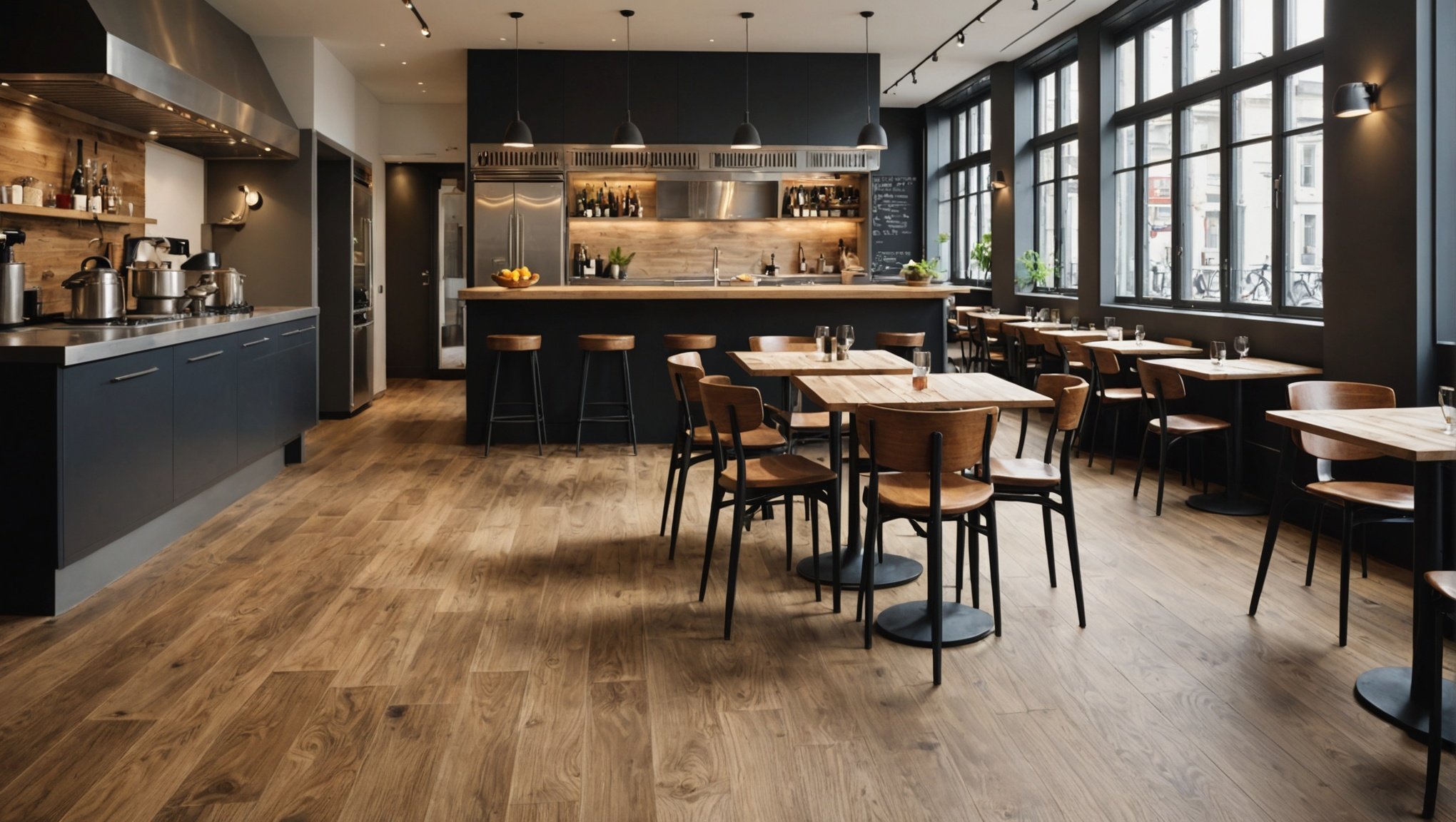The buzz of conversation, clinking of glasses, and sounds of the culinary process create an ambient symphony inside a restaurant. But when the noise level escalates, it can interrupt the dining experience, turning it from enjoyable to unbearable. This is particularly the case for open kitchen restaurants, where the kitchen forms part of the dining area. The noises from cooking activities, kitchen equipment, and the hustle-bustle of the staff can create unbearable noise levels that disturb your customers’ peaceful dining experience.
The good news? A significant portion of this issue can be addressed by selecting the right flooring. Strategic selection of flooring materials can reduce the noise that bounces around the restaurant, providing a more enjoyable dining space. This article discusses the types of flooring suitable for minimizing noise in open kitchen restaurants.
Have you seen this : What guidelines should be followed when installing a commercial espresso machine in a small cafe?
1. Vinyl Flooring — A Silent and Stylish Option
Vinyl flooring is a popular choice for commercial kitchens. It’s stylish, durable, and offers excellent soundproofing properties. Vinyl is a dense material, which means it’s highly resistant to sound transmission. This quality means that this flooring type can absorb the noise produced in the kitchen, preventing it from echoing throughout the dining area.
In addition to its soundproofing abilities, vinyl flooring is also highly durable and resistant to water and heat, making it perfect for busy kitchen environments. The material is easy to clean and maintain, which is essential in the kitchen where spills are common.
Also to read : How can interactive tabletop games enhance customer engagement in a family restaurant?
Vinyl flooring also comes in a variety of designs and textures, allowing you to match the aesthetic of your restaurant while also improving the acoustic environment.
2. Carpet Tiles — The Soft and Sound-Absorbent Solution
While not a traditional choice for kitchen areas, carpet tiles can be a great solution for the dining spaces of your open kitchen restaurant. Unlike vinyl and other hard flooring materials, carpet has natural sound-absorbing properties. Its fibrous nature allows it to absorb sound waves, reducing noise and enhancing the acoustic environment.
Carpet tiles are modular, meaning they can be easily replaced if stained or damaged. As a result, this could be a practical solution for dining areas where food and drink spills are more likely.
Please remember, however, that carpet tiles are not as resistant or easily cleaned as other types of flooring, so they may not be suitable for high-traffic areas or near the kitchen’s hustle and bustle.
3. Acoustic Panels — The Specialized Soundproofing Solution
While not strictly a type of flooring, acoustic panels will significantly enhance your chosen flooring’s soundproofing properties. These panels are designed to absorb sound waves, reducing echo and noise within a space. They come in a wide range of materials, including fabric, foam, and wood, and they can be installed on walls or ceilings to increase their effectiveness.
You can combine acoustic panels with any flooring type to create an even more soundproof restaurant. For example, you might choose a vinyl floor for its durability and easy cleaning, then add acoustic panels to the walls and ceiling for enhanced noise reduction.
4. Concrete — The Resilient and Robust Choice
Concrete flooring is a fantastic choice for restaurants seeking a modern, industrial aesthetic. But beyond its stylish appeal, concrete is also excellent for noise reduction in an open kitchen restaurant. The material’s density makes it highly resistant to sound transmission, helping to create a quieter dining space.
Both polished and textured concrete floors can reduce noise, but adding a sealant can improve this further. A sealed concrete floor is also easier to clean and maintain, making it a practical choice for both the kitchen and dining areas of your restaurant.
5. Cork — The Natural Noise Reducer
Cork is renowned for its excellent sound-absorbing properties. This makes it a fantastic flooring option for open kitchen restaurants looking to minimize noise.
Cork is composed of millions of tiny air-filled chambers that absorb sound waves, reducing noise transmission. This means that cork flooring can help absorb the sounds of kitchen activity, creating a quieter dining space for your customers.
In addition to being a natural sound reducer, cork is also a sustainable, eco-friendly flooring material. It’s incredibly durable, making it able to withstand the heavy foot traffic associated with commercial restaurants. Plus, cork is naturally resistant to mold, mildew, and pests, further increasing its lifespan.
So there you have it. From vinyl to cork, these are the top flooring options to consider when aiming to reduce noise in an open kitchen restaurant. Remember, choosing the right flooring material is one of the most effective ways to control noise levels and ensure that your customers enjoy their dining experience.
6. Rubber Flooring — The Flexible and Noise-Reducing Option
Rubber flooring is another practical choice for restaurants seeking both aesthetics and sound absorption. Made from rubber, a naturally elastic and dense material, this type of flooring acts as a great sound absorber, soaking up the clatter of dishware and reducing the hustle and bustle echo from the kitchen.
A significant advantage of rubber flooring is its incredible durability. It can withstand heavy foot traffic, physical impacts, and water spills, making it ideal for busy kitchens and dining areas. Moreover, rubber is a slip-resistant material, enhancing the safety of your restaurant staff and customers.
With its easy clean surface, maintenance is a breeze. You can quickly wipe off spills, ensuring your dining room always looks spotless. Rubber flooring is available in a wide array of colours, patterns and textures, offering you a chance to create a visually appealing dining space while achieving effective noise reduction.
7. Engineered Wood — The Stylish and Acoustic Flooring Solution
If you’re seeking a warm, natural aesthetic for your restaurant without compromising on sound absorption, engineered wood flooring is an excellent option. Composed of multiple layers of wood, this flooring type offers a robust and durable solution for restaurants.
Engineered wood is more dense than traditional hardwood, making it a superior option in terms of sound absorption. By reducing sound waves transmission, it helps to maintain a pleasant, calm environment in the dining room.
The top layer of engineered wood flooring replicates the natural beauty of various wood species, offering a high-end, luxurious feel. With proper care and maintenance, this type of flooring can retain its elegance and charm for a long time, even under high foot traffic.
The surfaces are sealed making them easy to clean and resistant to staining. This helps to ensure your restaurant stays looking its best for years to come.
Choosing the right commercial flooring for an open kitchen restaurant entails striking a balance between style, durability, and noise reduction. If you’re striving to create a dining experience that is both visually pleasing and acoustically comfortable, it’s crucial to consider the flooring material’s sound-absorbing capabilities.
From vinyl flooring to engineered wood, each material offers unique benefits for restaurant soundproofing. Whether you desire the durability and easy clean features of vinyl, the soft sound-absorbing characteristics of carpet tiles, the robust and stylish appeal of concrete, the natural noise reducer cork, the flexible and noise reducing rubber or the stylish and acoustic engineered wood, understanding your specific needs and restaurant’s aesthetic will guide you towards the right choice.
Remember, combining these flooring options with other sound-absorbing materials like acoustic panels can further enhance your space’s noise reduction capabilities. Strategically selecting and installing the right restaurant flooring can drastically reduce noise levels, helping to create a dining environment where customers can enjoy their meal without being disturbed by unwanted background noise.






